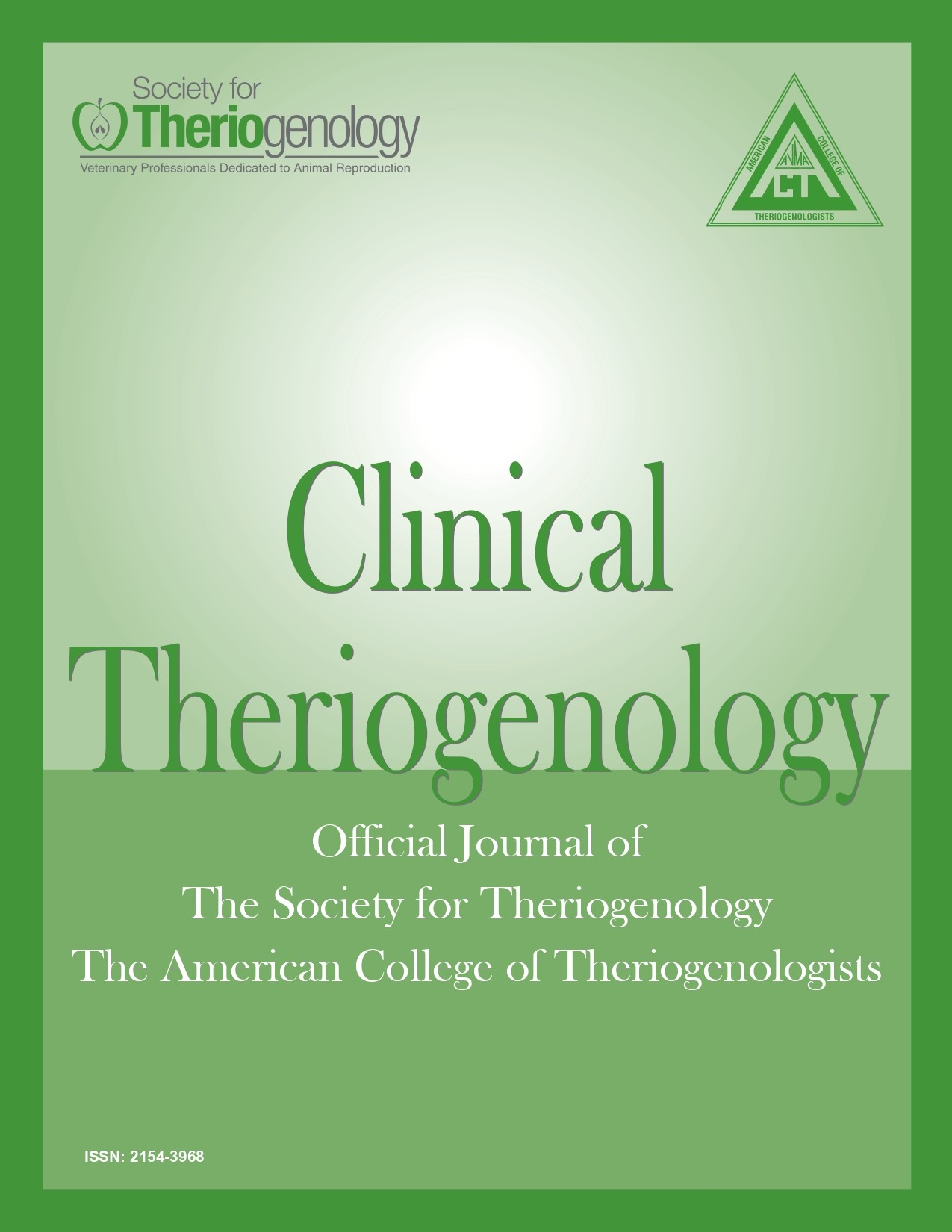Serum testosterone concentrations in alpacas and llamas after human chorionic gonadotropin stimulation before and after castration
Abstract
Veterinarians perform testosterone stimulation tests in animals suspected of bilateral cryptorchidism and/or incomplete castration. Period for circulating testosterone to become undetectable after castration varies among species. To our knowledge, clearance of circulating testosterone in camelids after castration has not been examined. Testosterone stimulation with human chorionic gonadotropin (hCG) has been described in several species, including alpacas. However, there is limited information regarding responses to hCG in male llamas. Purpose was to measure serum testosterone concentrations [T] in llamas and alpacas after hCG stimulation before and after castration. We hypothesized that [T] significantly increases after hCG treatment and decreases rapidly after castration. Testosterone stimulation test (using hCG) was performed in mature male alpacas (n = 9) and llamas (n = 7) 1 day prior to and 1 day after castration. Blood samples were collected; 1 sample before and 3 samples (2, 4, and 8 hours) after hCG treatment. In llamas and alpacas [T] increased (p < 0.05) > 2 fold (from prehCG values) within 2 hours after hCG treatment. PrehCG [T] were higher (p < 0.05) in alpacas than llamas but did not differ significantly between them after hCG stimulation; 24 hours after castration [T] were < 0.05 ng/ml.
Downloads
References
2. Esteller-Vico A, Ball BA, Bridges JW, et al: Changes in circulating concentrations of testosterone and estrone sulfate after human chorionic gonadotropin administration and subsequent to castration of 2-year-old stallions. Anim Reprod Sci 2021;225:106670. doi: 10.1016/j.anireprosci.2020.106670
3. Johnstone IP, Bancroft BJ, McFarlane JR: Testosterone and androstenedione profiles in the blood of domestic tom-cats. Anim Reprod Sci 1984;7:363-375. doi: 10.1016/0378-4320(84)90021-6
4. Kniewald Z, Zanisi M, Martini L: Studies on the biosynthesis of testosterone in the rat. Acta Endocrinol (Copenh) 1971;68:614-624. doi: 10.1530/acta.0.0680614
5. Sakase M, Weerakoon WWPN, Hannan MA, et al: LH and testosterone secretions in response to GnRH challenge in pubertal Japanese black beef bulls with normal and abnormal semen. J Vet Med Sci 2018;80:1829-1833. doi: 10.1292/jvms.18-0151
6. Dehejia A, Nozu K, Catt KJ, et al: Luteinizing hormone receptors and gonadotropic activation of purified rat Leydig cells. J Biol Chem 1982;257:13781-13786. doi: 10.1016/S0021-9258(18)33517-8
7. Haour F, Dray F, Mather JP: In vivo and in vitro response of Leydig cells to acute stimulation by hCG. Ann N Y Acad Sci 1982;383:231-248. doi: 10.1111/j.1749-6632.1982.tb23171.x
8. Bravo WP, Johnson LW: Reproductive physiology of the male camelid. Vet Clin North Am Food Anim Pract 1994;10:259-264. doi: 10.1016/s0749-0720(15)30560-0
9. Perkins NR, Frazer GS, Hull BL: Endocrine diagnosis of cryptorchidism in a llama. Aust Vet J 1996;74:275-277. doi: 10.1111/j.1751-0813.1996.tb13773.x
10. El Zawam A, Tibary A, Patino C: Basal levels and hCG response of serum testosterone and estrogen in male alpacas. Front Vet Sci 2020;7:595856. doi: 10.3389/fvets.2020.595856
11. Roser J: Equine profiles in fertile, subfertile, and infertile stallions: testicular response to human chorionic gonadotropin in infertile stallions. Bio Reprod Monogr 1995;1:661-669. doi: 10.1093/biolreprod/52.monograph_series1.661
12. Bergman B, Damber JE, Tomić R: Effects of total and subcapsular orchidectomy on serum concentrations of testosterone and pituitary hormones in patients with carcinoma of the prostate. Urol Int 1982;37:139-144. doi: 10.1159/000280809
13. Allrich RD, Christenson RK, Ford JJ, et al: Pubertal development of the boar: testosterone, estradiol-17 beta, cortisol and LH concentrations before and after castration at various ages. J Anim Sci 1982;55:1139-1146. doi: 10.2527/jas1982.5551139x
14. Cox JE, Williams JH: Some aspects of the reproductive endocrinology of the stallion and cryptorchid. J Reprod Fert Suppl 1975;23:75-79.
15. Ciccarelli M, Tibary A, Campbell AJ, et al: Effect of age and castration on serum anti-Müllerian hormone concentration in male alpacas. Theriogenology 2018;105:174-177. doi: 10.1016/j.theriogenology.2017.09.032
16. Marzok M, Moustafa A, El-Habashi N, et al: Evaluation of modified in situ pinhole technique for castration in horses. Kafrelsheikh Vet Med J 2016;14:163-179. doi: 10.21608/kvmj.2016.108687
17. McEachern R, Houle AM, Garel L, et al: Lost and found testes: the importance of the hCG stimulation test and other testicular markers to confirm a surgical declaration of anorchia. Horm Res 2004;62:124-128. doi: 10.1159/000080018
18. Memon MA, Ganjam VK, Pavletic MM, et al: Use of human chorionic gonadotropin stimulation test to do detect a retained testis in a cat. J Am Vet Med Assoc 1992;201:1602. doi: 10.2460/javma.1992.201.10.1602
19. Murase T, Okuda K, Sato K: Assessment of bull fertility using a mucus penetration test and a human chorionic gonadotrophin stimulation test. Theriogenology 1990;34:801-812. doi: 10.1016/0093-691X(90)90552-5
20. Santana M, Batista M, Alamo D, et al: Influence of sexual stimulation and the administration of human chorionic gonadotrophin on plasma testosterone levels in dogs. Reprod Domest Anim 2012;47:43-46. doi: 10.1111/j.1439-0531.2011.01923.x
21. Mialot JP, Thibier M, Toublanc JE, et al: Plasma concentration of luteinizing hormone, testosterone, dehydroepiandrosterone, androstenedione between birth and one year in the male dog: longitudinal study and hCG stimulation. Andrologia 1987;20:145-154. doi: 10.1111/j.1439-0272.1988.tb00678.x
22. Sundby A, Ulstein T: Plasma concentrations of testosterone in the male dog and plasma testosterone profile following single intramuscular injection of HCG. Acta Vet Scand 1981;22:409-416. doi: 10.1186/BF03548666
23. Tremblay Y, Belanger A: Changes in plasma steroid levels after single administration of hCG or LNRH agonist analogue in dog and rat. J Steroid Biochem 1985;22:315-320. doi: 10.1016/0022-4731(85)90432-7
24. Andresen O: 5alpha-androstenone in peripheral plasma of pigs, diurnal variation in boars, effects of intravenous HCG administration and castration. Acta Endocrinol (Copenh) 1975;78:385-391. doi: 10.1530/acta.0.0780385
25. Rhodes RC, Fleming MW: Unilateral orchidectomy of ram lambs: acute, chronic and hCG-stimulated androgen levels. Comp Biochem Physiol 1987;87:627-630. doi: 10.1016/0300-9629(87)90372-0

This work is licensed under a Creative Commons Attribution-NonCommercial 4.0 International License.
Authors retain copyright of their work, with first publication rights granted to Clinical Theriogenology. Read more about copyright and licensing here.





